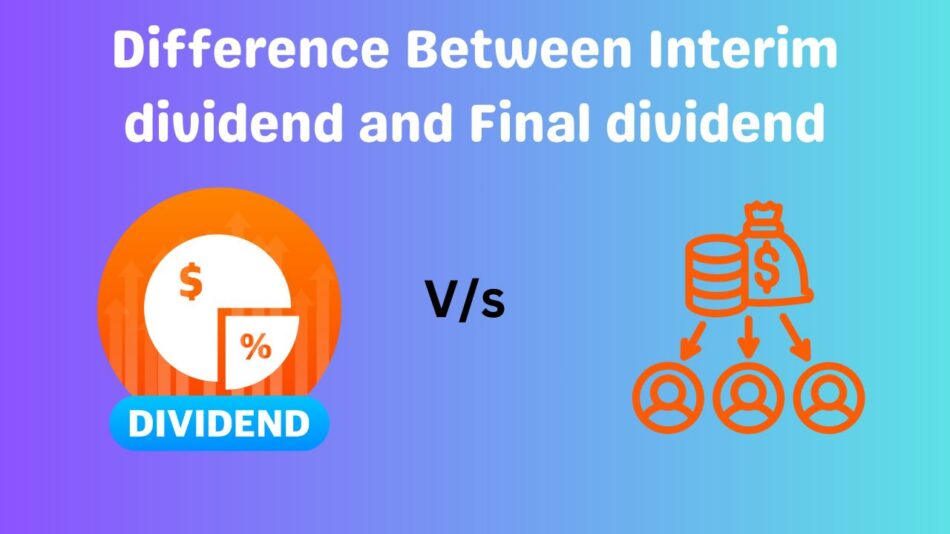In corporate finance, understanding dividends is crucial for both companies and investors. Dividends represent a portion of a company’s earnings distributed to shareholders and can be a significant factor in investment decisions, especially concerning dividend stocks. Two primary types of dividends that companies can issue are interim dividend and final dividend. This article explores the fundamental differences between interim and final dividends, their implications for dividend stocks, and how investors might perceive these in the context of the Indian stock market.
What are Dividends?
Dividends are payments made by a corporation to its shareholders, usually as a distribution of profits. While many companies aim to return a portion of their earnings to investors as dividends, it is important to note that not all companies do so. The decision to pay dividends and the amount to be distributed is at the discretion of the board of directors.
Interim Dividend
Definition
An interim dividend is a dividend payment made before a company’s Annual General Meeting (AGM) and the release of its final financial statements. Typically, interim dividends are declared at the end of a company’s fiscal half-year, based on its performance during this period.
Characteristics
Frequency and Timing:
Interim dividends are usually paid out once or more within the financial year, typically after a six-month accounting period.
Declaration:
The decision to declare an interim dividend lies with the company’s board of directors and does not require shareholder approval.
Financial Position:
The capacity to pay an interim dividend is generally determined by short-term financial performance and liquidity, rather than the comprehensive annual results.
Example Calculation
Suppose XYZ Ltd., a well-performing IT company, decides to pay an interim dividend of INR 3 per share. If an investor holds 500 shares, the total interim dividend received would be:
Interim Dividend = Number of Shares × Dividend per Share
Interim Dividend = 500 × 3 = INR 1,500
Final Dividends
Definition
A final dividend is declared at the end of a company’s fiscal year during its AGM and is based on the finalised financial results for the period. It usually represents a larger distribution compared to interim dividends.
Characteristics
Timing:
Final dividends are declared after the annual accounts are prepared and audited. This is typically done at the company’s AGM.
Approval:
Unlike interim dividends, final dividends require the approval of the company’s shareholders during the AGM.
Comprehensive Performance Review:
It reflects the overall performance and profitability of the company over the entire financial year.
Example Calculation
If XYZ Ltd. decides to pay a final dividend of INR 7 per share after evaluating its annual performance, and an investor holds 500 shares, the total final dividend received would be:
Final Dividend = Number of Shares × Dividend per Share
Final Dividend = 500 × 7 = INR 3,500
Key Differences
Timing of Declaration and Payment
Interim dividends are declared and paid during the year, whereas final dividends are declared and paid after the year’s end.
Approval Requirements
Interim dividends do not require shareholder approval, while final dividends do, as they are subject to a vote at the AGM.
Financial Assessment
Interim dividends rely on short-term financial performance, while final dividends consider the entire financial year’s results.
Risk and Uncertainty
Interim dividends might be considered more uncertain, as they are declared based on partial year data, whereas final dividends reflect a complete year’s performance.
Implications for Dividend Stocks
Dividend stocks, which pay out dividends to shareholders, often appeal to investors seeking regular income. The distinct nature of interim and final dividends can influence the attractiveness of these stocks:
Predictability:
Investors favouring predictability may lean towards companies with a consistent record of paying final dividends since they are based on full-year performance.
Regular Income:
Stocks offering interim dividends might attract those looking for more frequent payouts, despite their potential variability.
Performance Signals:
Interim dividends can be a signal of robust performance, prompting investor interest. However, frequent high interim dividends without supporting annual results might raise sustainability concerns.
Conclusion
Understanding the differences between interim and final dividends is vital for investors involved in dividend stocks, as these distinctions can impact the security and expectations tied to dividend income. While interim dividends may provide more frequent payouts, final dividends often offer a more stable view of a company’s annual performance.
As with any financial decision, investors should diligently evaluate the nuances of interim and final dividends within the broader context of their investment strategies and market conditions. The Indian stock market, with its dynamic nature, offers various opportunities but equally demands careful consideration of the associated risks.
Disclaimer
This article serves educational purposes and should not be construed as financial advice. Investing in the Indian stock market involves risks, and it is important for investors to conduct thorough research and consider all pros and cons before making investment decisions. Always consult with a financial advisor or conduct your independent assessment of the market conditions and company performance when dealing with equity investments like dividend stocks.







